

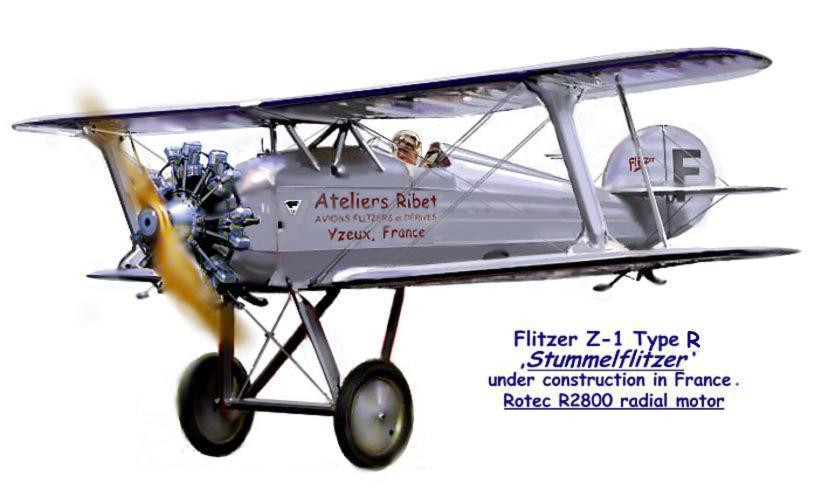
 |
 |
|||
| 1 | 2 | 3 | ||
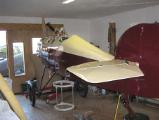
November 15, 2003
Hello Flitzerfans,
Here are the first pictures from Herve Ribet, in France, of the very first prototype of the Flitzer Z-1 Type R Stummelflitzer aerobatic biplane. For those who don't know, this is a four-aileron, dedicated aerobatic development of the Z-1, Z-21 and Z-1 Type S, especially adapted for the Rotec R2800 seven cylinder, 110 hp. radial engine, which is causing such tremendous interest among homebuilders.
Together with the prototype SK26, (and possibly the Tigerfalk), these three biplanes represent distinct character types, which, though superficially different, retain many characteristics in common, and are all wooden, single seaters, of similar size, designed with aerobatics in mind. It is intended that all will be equipped with the R2800!
I see the Type R as an exciting departure, as it was the first of the Flitzer series to be specifically considered for the R2800, and had increased reserve factors designed-in. The unique 'double V' internal plywood stiffening to the liftwire pick-up positions may be observed. The SK26 has been modified to accept the R2800, while the Tigerfalk, a pre-Flitzer design with a more advanced wing section and bigger, swept-back wings, and of a later period style (1930s), was designed around a 90 hp. Salmson radial, for which the Rotec R2800 is a perfect substitute. I have included a side elevation of the proposed SK26 with a radial motor, and the recently skinned fuselage of Rupert Wasey's Flitzer Z-21 'Roundtail'.
Congratulations to Herve for boldly advocating this developemnt and deciding that he would build a no-compromise aerobatic machine, in the glorious tradition of radial engined biplanes, which many designers favoured between the wars, and is still an unbeatable combination for vintage appeal today.
Validation of the performance of this machine will be an eagerly awaited experience.
Best wishes,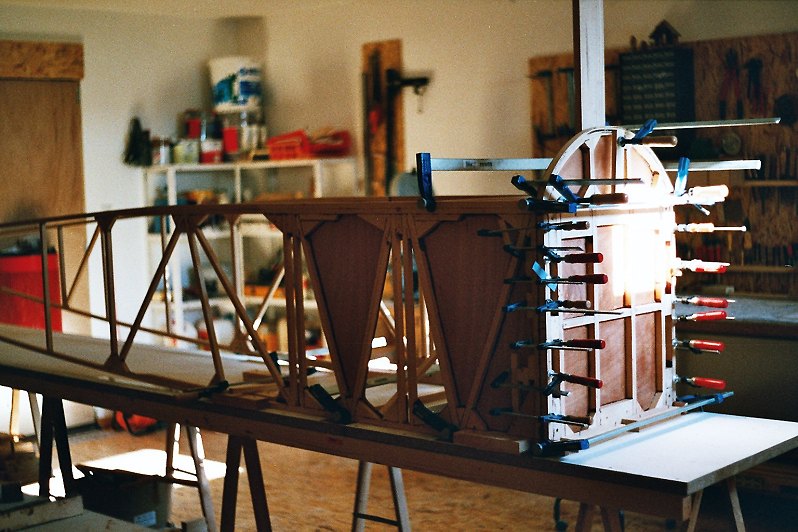 |
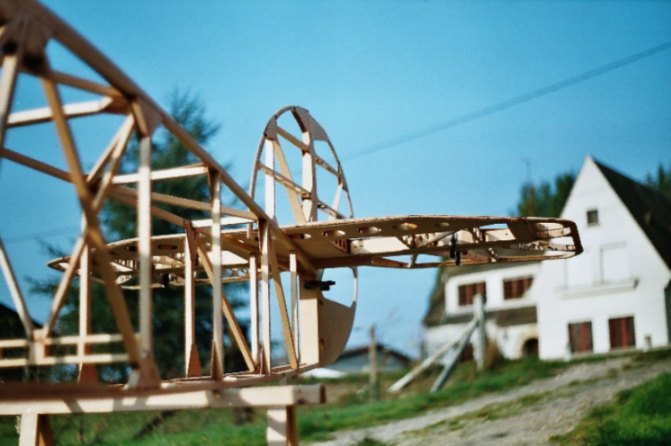 |
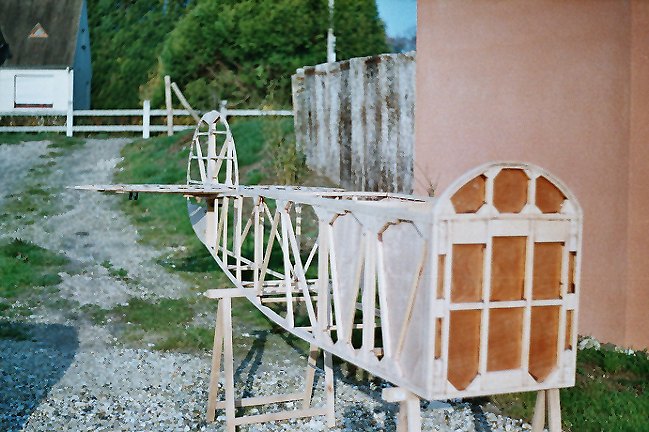 |
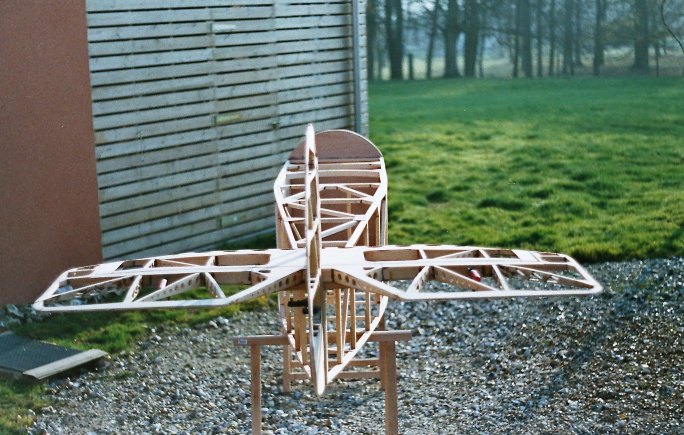 |
 |
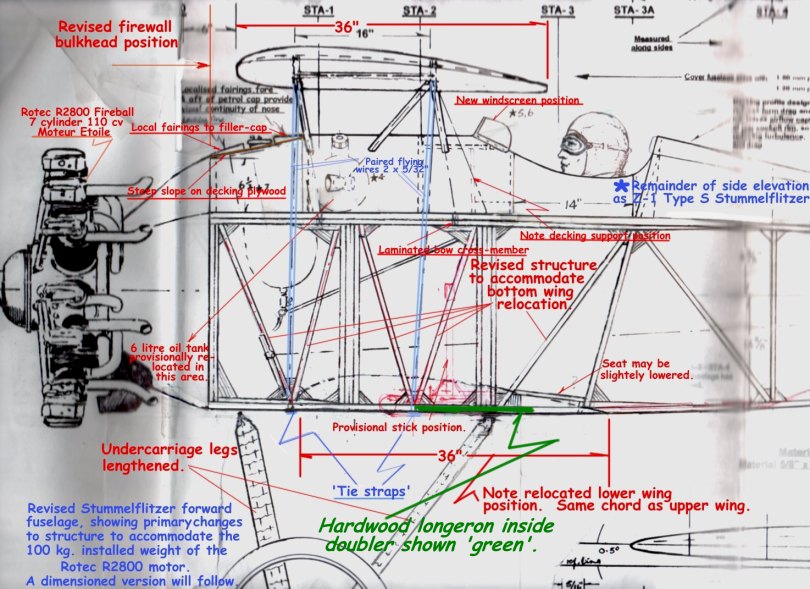 |
| Rupert Wasey's Z-21 "Roundtail" |
September 4, 2004
Hello Herve and Gary,
Thank you for the photographs, Herve. They are exactly as I had intended that you would assemble the centre-fuselage area. Excellent progress.
I am sending this data to Gary Steadman for his appraisal. The apparent close proximity of several cross members is illusory in one picture in particular, Gary, until you observe that two of these are in the plane of the lower longeron, which makes the arrangement look inefficient, but was actually a force majeur due to the requirement of moving the lower wing to its new forward position, and keeping the flying wires at zero sweep in side elevation.
Note the 'vee' shaped plywood shear webs on the inner-fuselage to stabilise the twin diagonal vee-struts in the fuselage at the load point, the outer fuselage ply not yet having been attached. This is a mighty strong aeroplane, I think, Gary. Tres forte, Herve!
Keep up the good work!
Bon chance,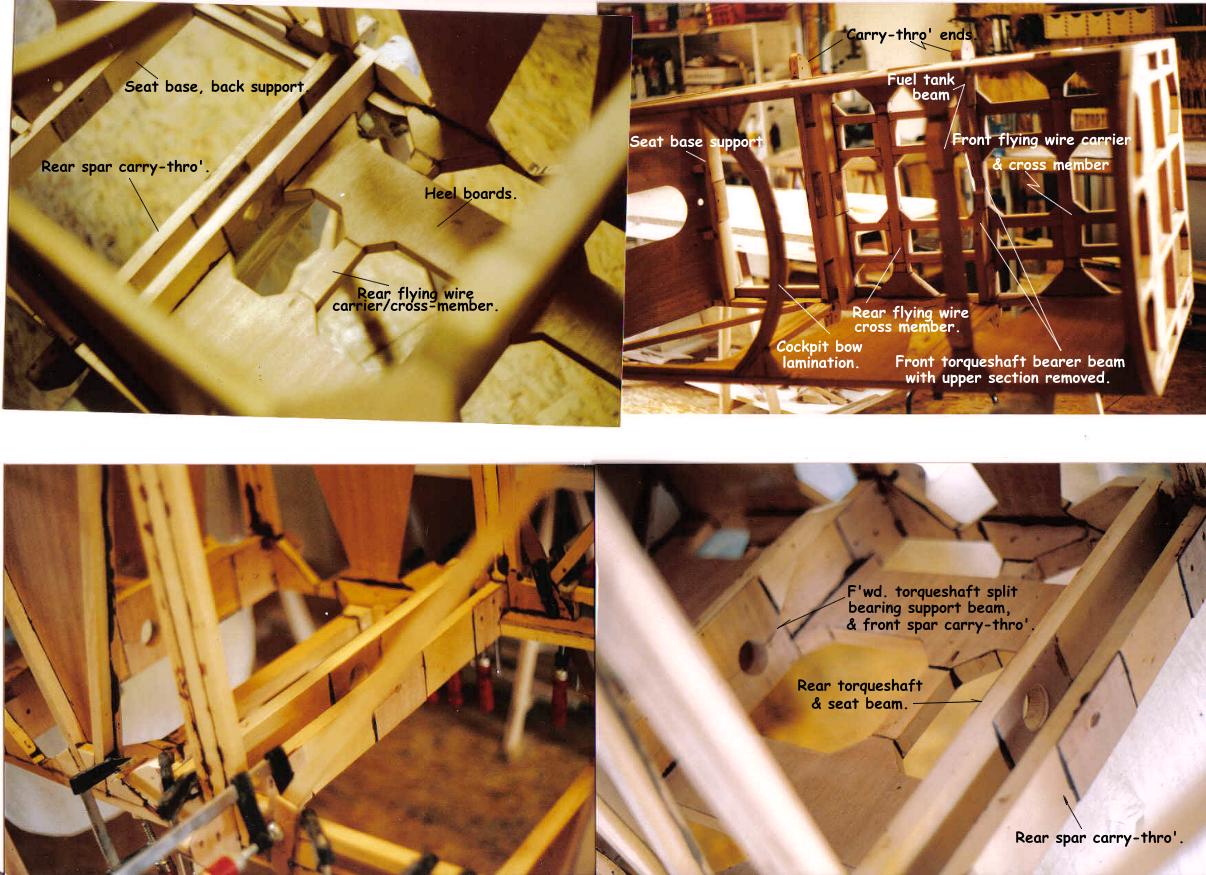
January 23, 2005
Hi Group,
Here are the very latest pictures of Herve Ribet's Stummelflitzer Special, the first of the Z-1 Type R 'advanced' aerobatic variants especially adapted for the 110 hp. Rotec R2800 radial engine.
Herve has been making excellent progress on this exciting aeroplane, in between exploring the aerobatic envelope of the CAP 10. It has some additional features which we have discussed that have been built-in, such as the new entry step on the port lower longeron, for those of us who are 'vertically challenged'! The Type R will stand higher off the ground than either the Type S or the Z-21, (probably as tall as bigger the Z-3 Falke) and with the lower wing moved forward (this wing being situated even higher off the ground in a tail-down attitude) it was felt necessary to equip the prototype with this additional pilot's aid to mounting the aeroplane; the wing walk still being retained as the 'second step'.
Another addition will be to install two further fuel tanks of approximately 3 Imp. gals each, in the upper wing roots, in the same manner as in the Z-3 Falke. Although these will be smaller than those of the Z-3, due to the more slender wing and smaller chord, a larger external tank 'sump' might be included to allow a litre or more of additional fuel per side.
The plywood covering to the leading edge of the tailplane on this Type R is not part of the original design, which is intended to have the nose ribs merely fabric-covered, there being sufficient strength in the Stummelflitzer tailplane without a 'D' cell. However, Herve has ply-covered the LE and introduced lightening holes in the ply. It may be difficult to avoid these holes creating a somewhat distorted fabric contour at the leading edge, as the fabric shrinks around the holes on the curve, and it may be necessary to locally re-skin with 0.4 mm model aircraft Liteply over the holes before covering.
On small error may have to be altered, and that is the angle created by the 'corners' of the firewall bulkhead laminations at the upper longeron, in relation to the fuselage sides. In order for the plywood decking-wrap over the tank bay to flow smoothly into the fuselage sides, the laminations have to meet the corner at 180 degrees. Otherwise it will not be possible to obtain the important full plywood glue joint which enables the tank-bay ply skin to accept the fuel tank loads under high negative G. It may be necessary in any case to re-inforce the tank bay with straps to accept higher loads in this area.
Rupert had this same problem, and the solution which I suggested at the time, (which worked) was to add some further laminations, if necessary using plywood, starting at the 'corner' each side, and blending these into the existing curve about 1/2 way to the top, sanding everything smooth once a compatable contour is achieved.
Another thing that will be necessary for the aerobatic case, with the bigger engine, is to increase the four engine mount holes in the ash corner blocks on the firewall bulkhead, from 5/16" to 3/8" (10mm) dia.
Otherwise the aeroplane looks wonderful, and the 'short-nosed' impression of the radial engine machine is already apparent! The wheels should be ready in Cardiff by next week, and once these are in place, I think Herve will be amazed by how tall the aeroplane will be! I cannot wait to see pictures of that, with Herve standing alongside looking up! It's going to be one of the biggest 'little' biplanes on the planet!
Lynn |
 |
 |
 |
 |
 |
 |
January 05, 2006
Group,
I have pleasure in forwarding these pictures, taken in October last year, showing the progress on Herve's Stummelflitzer Z-1 Type R, in Northern France.
This variant, with the R2800 radial engine installation, four mass-balanced ailerons and mass and aerodynamically balanced elevators, is perhaps the most sophisticated of the Z-Type variations so far, along with the Z-2.
I am uncertain whether Herve's aeroplane will also have upper-wing fuel tanks as intended, (as featured on the Z-3) since he is now looking at substantially increasing the volume of the fuselage tank.
Herve has also completed the tailgroup, which may be seen on two of the shelves, and the main undercarriage, and like many others, his wheels were built by Richard's Brothers in Cardiff, and were delivered a while ago.
Congratulations to Herve, who I hope will be among the growing French contingent at Kemble in 2006, and will hopefully be flying there in style, in 2007!
Best regards,
Lynn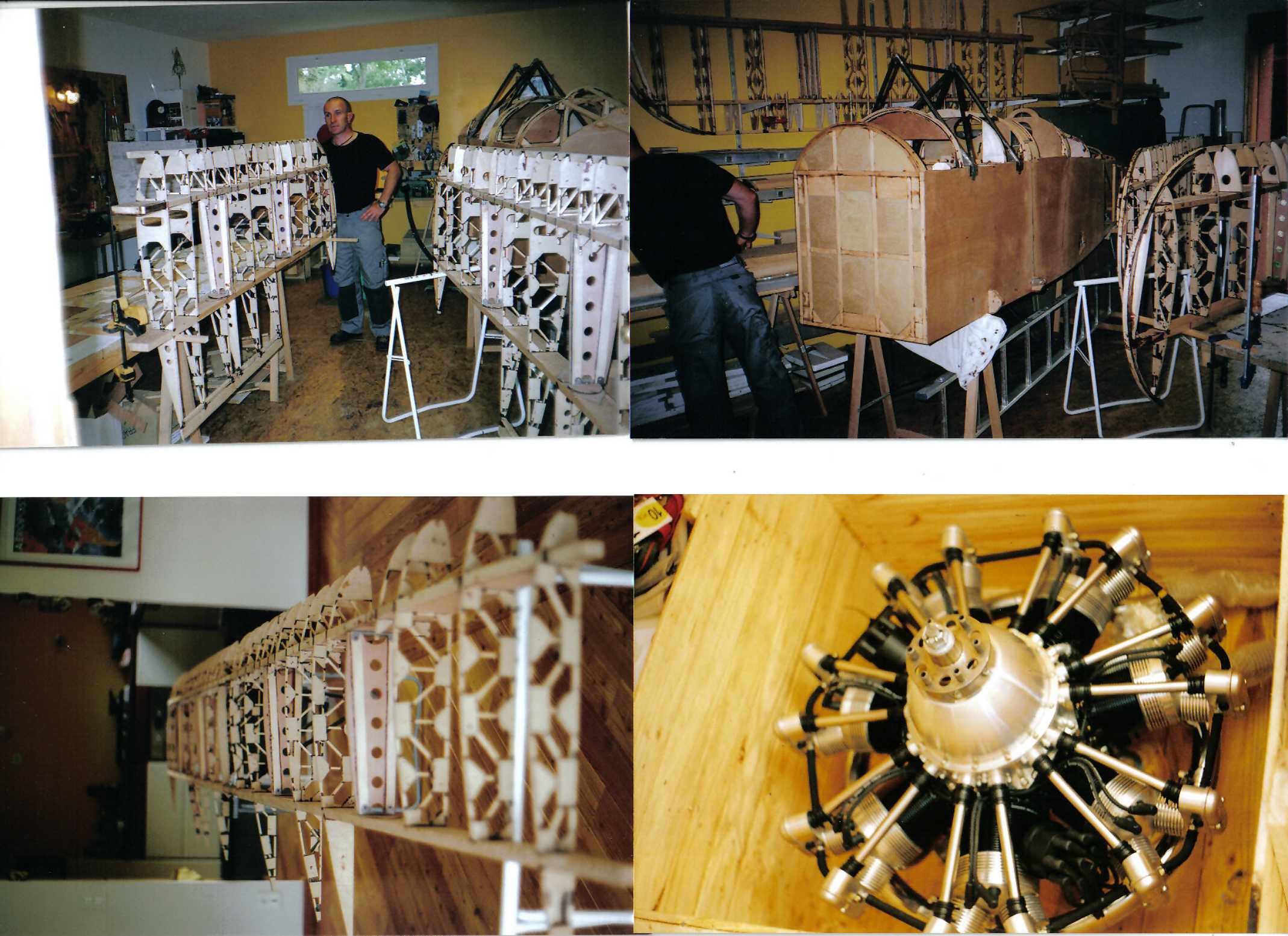
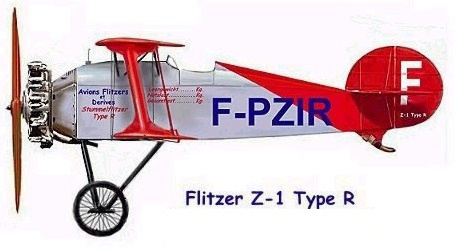
May 2, 2006
Group.
First picture of the R2800 on the front of a Stummelflitzer Type R fuselage.
Fabulous work from Herve Ribet, as expected.
LynnJune 28, 2006
Group,
This is Herve Ribet's new increased capacity 11.4 Imp. gals (52 litres) main tank for the Stummelflitzer Type R (R2800 Rotec radial motor).
I have suggested a provisional strap system for supporting this new shape, but the true dimensions are not known, so the rear strap position may actually be re-located ahead of the forward cabane root. Therefore the attached data is very provisional. However, I am sending this as a provisional idea only.
I don't yet know whether Herve intends to install the twin 3.5 gal. pannier-tanks which are designed to fit each side under the curved side-panel contours of the fuselage, on CG, behind the radial motor.
Lynn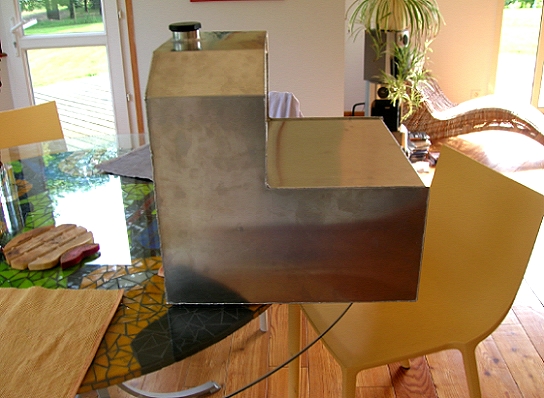 |
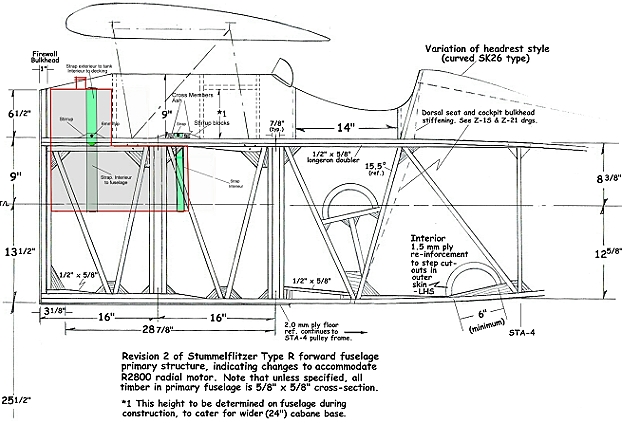 |
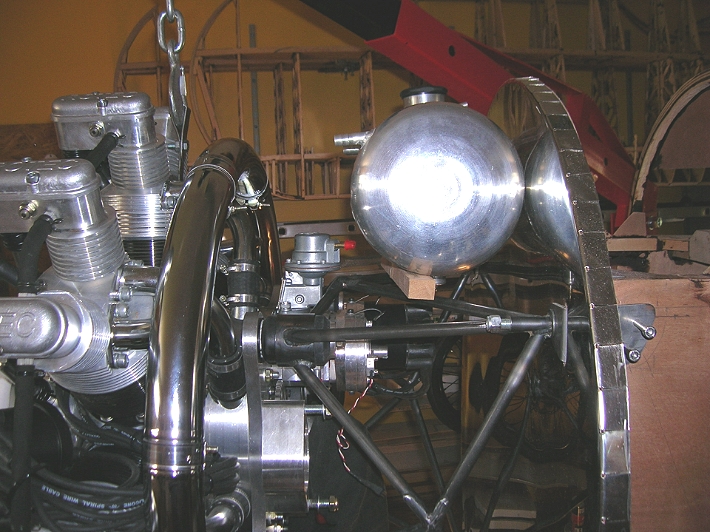
 |
 |
|||
| 1 | 2 | 3 | ||